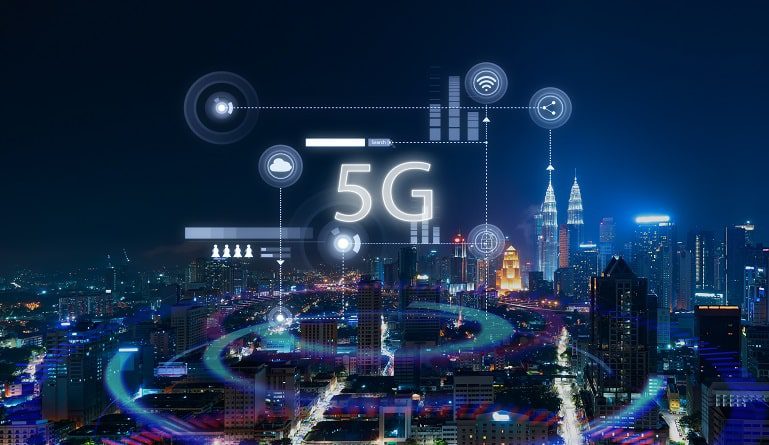The arrival of 5G technology marks a revolutionary shift in how businesses and IT systems connect, communicate, and operate. Unlike previous generations of mobile networks, 5G offers ultra-fast speeds, near-zero latency, and the ability to support massive device connectivity—all of which are game-changers for modern enterprises. From enabling real-time collaboration to powering smart factories and remote workforces, 5G is not just an upgrade—it’s a catalyst for innovation and transformation. In this post, we’ll explore seven major ways 5G is reshaping IT infrastructure and business connectivity, and why companies should prepare to embrace this next-gen network.
⚡ Lightning-Fast Speeds and Real-Time Communication
One of the most immediate benefits of 5G is its incredible speed. With data transfer rates reaching up to 20 Gbps under optimal conditions, businesses can experience seamless communication across platforms, faster cloud access, and instant file sharing. This speed dramatically improves productivity, especially in industries that rely on large data sets, high-definition video conferencing, or real-time collaboration tools. IT teams can deploy updates and patches faster, while employees can work more efficiently without lag or delays. For customer-facing applications, faster speeds mean smoother user experiences and quicker service delivery, giving businesses a competitive edge.
⏱️ Ultra-Low Latency for Mission-Critical Applications
Latency—the delay between sending and receiving data—is drastically reduced with 5G, often to less than 1 millisecond. This ultra-low latency is crucial for applications that require real-time responsiveness, such as autonomous vehicles, remote surgeries, industrial automation, and augmented reality. In IT environments, low latency enhances system performance, reduces downtime, and enables faster decision-making. Businesses can deploy sensitive systems that rely on immediate feedback, such as live monitoring tools, predictive analytics, and AI-driven automation, without worrying about delays that could compromise operations or safety.
🤖 Supporting Massive IoT Deployments
5G is designed to handle up to one million connected devices per square kilometer, making it ideal for Internet of Things (IoT) ecosystems. Businesses can deploy thousands of sensors, smart devices, and connected machines without network congestion. This opens the door to smarter warehouses, real-time asset tracking, intelligent energy management, and automated manufacturing lines. IT departments benefit from centralized control and data collection, while business leaders gain deeper insights into operations. The ability to scale IoT deployments without sacrificing performance or reliability is a major advantage for companies looking to innovate and optimize.
🧠 Enabling Edge Computing and AI Integration
With 5G’s speed and reliability, businesses can shift from centralized cloud computing to edge computing—processing data closer to its source. This reduces latency, lowers bandwidth costs, and improves real-time decision-making. Combined with AI, edge computing allows businesses to analyze data on-site, detect anomalies instantly, and automate responses without relying on distant servers. IT teams can deploy smarter infrastructure that adapts to changing conditions, while businesses can deliver personalized services, optimize logistics, and enhance customer experiences. The synergy between 5G, AI, and edge computing is a powerful driver of digital transformation.
🔒 Enhanced Security and Network Slicing
Security is a top concern in the digital age, and 5G introduces advanced features to address it. One of the most innovative is network slicing, which allows businesses to create isolated virtual networks within the same physical infrastructure. Each slice can be customized for specific applications, ensuring dedicated bandwidth, performance, and security. This is especially valuable for industries like healthcare, finance, and manufacturing, where data protection and reliability are critical. IT teams can manage multiple secure environments simultaneously, reducing risk and improving compliance with regulatory standards.
🌍 Empowering Remote Work and Global Collaboration
The rise of remote and hybrid work models has made reliable connectivity more important than ever. 5G enables high-speed internet access in areas where wired connections are limited or unavailable, allowing employees to work from virtually anywhere. Teams can collaborate in real time, access cloud-based tools, and participate in HD video meetings without interruption. For businesses with distributed teams, field operations, or international partners, 5G ensures consistent performance and connectivity across geographies. IT departments can support remote users more effectively, while businesses maintain productivity and agility in a flexible work environment.
📈 Driving Innovation and Competitive Growth
Ultimately, 5G is a catalyst for innovation. It enables new business models, smarter services, and more efficient operations. Companies can explore immersive retail experiences, connected healthcare systems, autonomous logistics, and intelligent customer engagement platforms. With faster data processing, enhanced connectivity, and scalable infrastructure, businesses can respond to market changes quickly and seize new opportunities. Early adopters of 5G gain a strategic advantage, positioning themselves as leaders in their industries. For IT professionals and business executives alike, embracing 5G is not just about keeping up—it’s about moving ahead.


